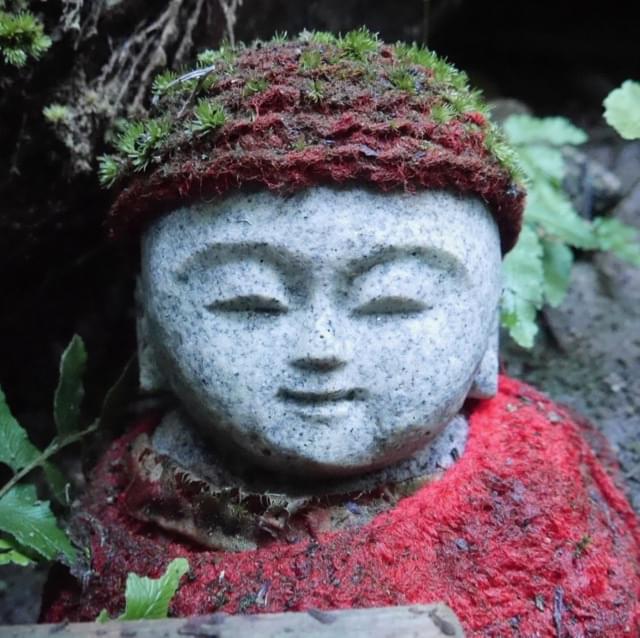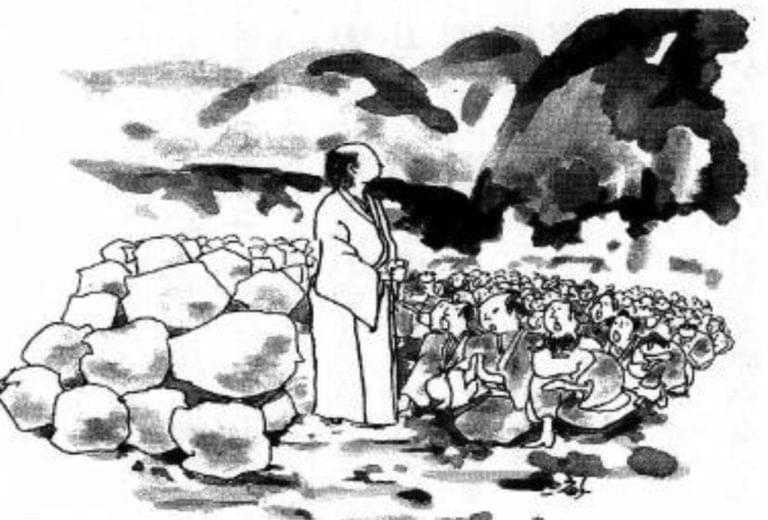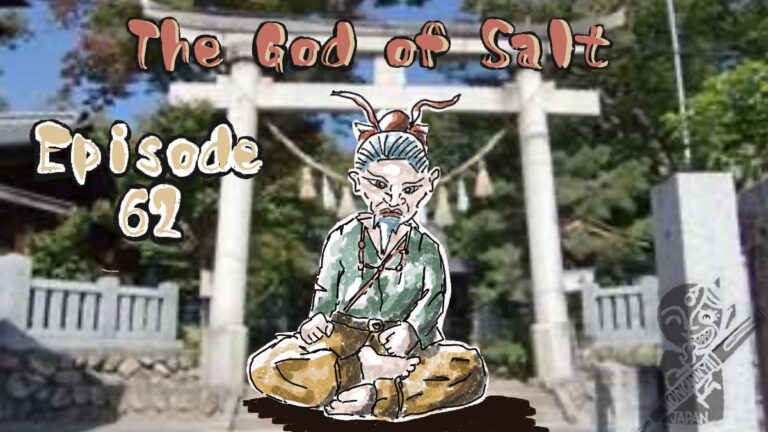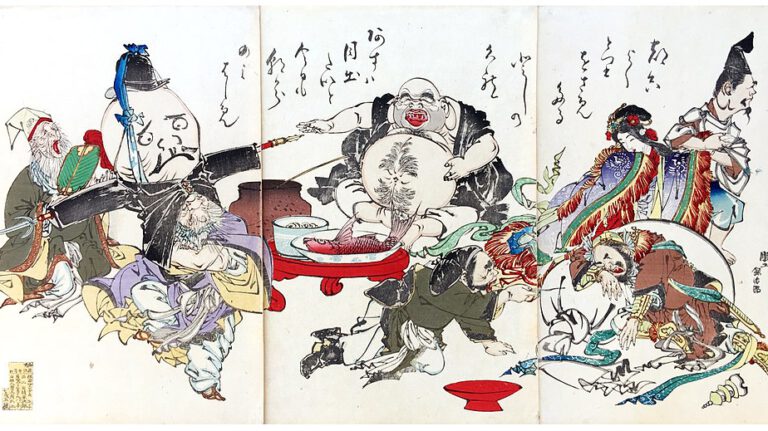This is Thersa Matsuura and you’re listening to Uncanny Japan.
I’m sure you’ve heard, Japan is open to tourists again. It was closed for, what (?) two years? But not anymore! And, maybe you’ve also heard, the new Ghibli Park is open. I have to admit Richard and I had a little giggle when we watched someone on Youtube walk through parts of it on opening day. We were like, old fashioned backstreets, wells, retro trains with cloth seats, wait, this is just inaka, or countryside, or a lot like where we live. We can see that for free! I kid. They’re opening the park in phases, it looks like. And there will be nature to inhale, loads of Ghibli characters to look at, and gift shops, but boy do I wish they’d make a functioning Neko Bus to drive around the park and carry people around or a functioning Howl’s Moving Castle.
Anyway, today I’m going to tell you about something different you can do while visiting Japan. It’s much older, but also super neat that will — if you play your cards right — get you in good with the gods.
Stay put. I’ll be right back.
Intro.
Binaural Sounds from Houkouji for Patrons
Hey hey, how are you? Mm hm. Yeah, me, too. But here’s something nice: Today’s background ambiance is brought to you by my visit to Houkouji, a Zen temple in the mountains of Hamamatsu. So let’s pretend that’s where we are right now, hanging out with the trees and birds.
The binaural soundscape-only version — no me yappering on — will be up for patrons soon for your studying, relaxing, or sleeping pleasure. I’ll also post a bunch of photos and neat things I learned while there, too. If you’d like to become a patron and help support the show, my writing and get the extra content, you can do that for like $5 a month, or there’s an 8% discount if you pledge for a year. And I think Patreon is accepting more and more different currencies, too.
Remember the little audio short story I told you about last time? Kuwazu Nyobo. “The Wife Who Didn’t Eat”? Yeah, at the moment I’m recording this, it’s still not up. Submitted, being distributed, and waiting. So any day now, perhaps? I’ll let you know.
The Meaning of Goshuin
Okay, today — thinking about those who are planning to visit Japan for the first time or returning after quite awhile — I want to tell you about something I love to do, in case you don’t know about it. It’s called goshuin.
Go/御 is honorific. Shu/朱 is the character for red, but more specifically vermillion. And in/印 means mark, stamp, or seal. A very short explanation is a goshuin is a stamp or seals that visitors can collect when they visit Shinto shrines or Buddhist temples. They’re beautiful calligraphy and vermillion stamps that show that you visited and prayed at that particular shrine or temple.
I’ll get into more detail in just one moment, but I’m going to go all mom for a second.
Manners and Goshuin
I want to preface this with, I know all of you all are sincere and respectful and beautiful honest human creatures, really good people. So I’m not telling you this specifically, but if you know of anyone who wants to collect goshuin or is and they’re kind of doing it in an uncool way, you could always gently enlighten them. Pun was unintentional but I’m keeping it.
Collecting goshuin is not anything like a stamp rally, where you have a map or piece of paper and go around collecting stamps from different places or stations, trying to get them all. Stamp rallies being a fun activity that you do with friends or alone, but it is in no way a spiritual undertaking.
Goshuin, on the other hand, are. You collect them from temples or shrines and there is a certain amount of respect and manners involved with the whole prodedure. I’ll get to that in a minute, too. The rules or manners will make more sense after I tell you a little more about what they are and how you can collect them.
What Temples/Shrines Do Goshuin
So you already know they are some kind of stamp or seal that you can get from temples and shrines across Japan. Not all, though, there are many smaller, unmanned places that don’t offer them. Or maybe you have to call ahead and have someone meet you at a certain time. For example, the wolf shrine/temple I went to was like that. I was expecting someone to be there, but there was no one anywhere at all. Even at the small souvenir area. I learned later that if I had called, someone would have gone up the mountain to meet me.
That said, it’s safe to say, though, if you’re going to a medium to larger temple or shrine, you’ll definitely find the goshuin window. I’ll put the kanji up in the show notes, but it’s usually where you’ll find omamori and ofuda/ good luck amulets sold, off to the side of the main temple or shrine. A bit of trivia for you: in Shinto the priest who performs this is called a Shinshoku/神職 and in Buddhism, they’re called a Juushoku/住職.
Goshuincho/The Goshuin Book
Okay, so what you need to do is first get yourself a goshuincho/ご朱印帳 or goshuin booklet. These are usually also sold where you get the actual stamp so that makes it easy. Or you can find them in larger bookstores or stationary shops if you want to shop around. You can choose from all kinds of covers. Plain ones, fancy ones, cloth ones, wooden ones, Hello Kitty ones, and I just bought a Hyakki Yagyō/Night Parade of a Hundred Demons one, like I said, all sorts. Bigger temples will have their name on them, which makes them special. They cost anything from a thousand yen to more, depending on how extravagant you want to go.
You can’t use just any notebook, you must invest in one of these neat books, because they’re special in another way. When you open it, you’ll find the pages are actually one very long piece of paper folded accordion-like, if you’ve ever seen Buddhist religious texts or sutras, they’re often in this fashion. It’s very old and came from China.
The Order of Things
So first things first, it is proper to pray first at the temple or shrine before getting your book stamped. The stamp isn’t just a sign that you visited, but it’s also a kind of bond between you and the god or gods or deities enshrined there. It’s between you and them. No one is going to horn in on your prayers. But it’s the polite thing to do, so go toss in a coin (5 yen, 100 yen…) into the saisenbako, that slotted wooden box in front of the temple and “te wo awasete”/place your hands together and quietly pray.
If you’re at a Shinto shrine it goes: money, jangle bell rope, bow twice, clap twice, pray, then bow once.
After you’ve finished this, called omairi, then head over to the goshuin area. A stamp will cost usually 300 yen, but sometimes more, depending. Fancier stamps cost more or certain times of year, events. This part always makes me awkward.
Because a lot of places you pay after they’ve finished. Some though will give you a plastic number thingy and you pay first. You can come back later after you’ve walked around or wait to be called. I smile and bow a lot. That’s my recipe for staying out of trouble, too.
Anyway, open your goshuincho to the page you want stamped, turn it to face the monk, so they don’t have to turn it around before they write, and hand it to them with both hands. You can yoroshiku onegaishimasu here, too.
You can stay and watch if they get to it right away. I quite love watching them do the calligraphy. But sometimes they’ll have a whole bunch of books or the monk who has the best calligraphy isn’t there at the moment, so you’ll have to wait. You can wander around a bit. Whatever I do is awkward, so I don’t know how to give advice here.
When they’re done writing it, either you’ll be right there watching or be called or come back after a stroll through some side paths. Whatever the case, pay if you haven’t yet, take it in both hands and thank you and bow.
There!
The Goshuin Stamp Itself
There really is something, I think, magical about goshuin. The pressing the wooden carved seals into the sticky vermillion ink and then into your book, the brush dipped into freshly ground black ink, the characters written in that particular monk’s style, then switching to a smaller brush for different parts of the page, smaller stamps, too. Such attention to detail and care. Oh, and something else I always think about and anyone who has every studied or practiced Japanese calligraphy also knows, is they really can’t mess up. Even more so in your goshuincho because it is absolutely impossible to tear out a page and start over. So that moment that they are writing and stamping, they are fully concentrated, one mind, all that. I mean how many times have I written the date wrong in my journal or went to make a grocery list and spelled something wrong just because I was thinking about the next thing on the list. None of that.
Funny Story
I think I’ve told this story before, but I’m not sure, so I’m going to tell it again. My in-laws decided to take us to Kamakura ages ago, before Julyan was even born. That’s the first time she taught me about the whole goshuin tradition. Well, since we’d go to get ours done at the same time, we’d often get two different monks writing them and we liked to compare the calligraphy afterward, because I was studying it at the time and, well, it’s just so beautiful. We got to this one temple and there were several monks sitting and waiting and I nudged her and made motioned to the knock down drag out gorgeous monk. — Hey, I was like 23 at the time — She eye rolls, yeah yeah. So I immediately marched up to his window while went to the one beside him. Her monk wasn’t so hot, but that’s okay. Mostly we were in a competition for who could get the most distinctive and gorgeous writing. When we were done we scooted off under some trees to compare and hers was sooo much more stunning that mine. Mine was okay. That’s when she told me about beautiful faces and pure hearts.
Taking care of the Goshuicho Book
When finished a monk will never blow on the ink to dry it, instead they’ll grab a little piece of newsprint cut to size and slip it between the pages so it doesn’t dirty the blank page or seal across from it. Very thoughtful.
If you’re lucky they’ll stick in a piece of paper or postcard with more information about that particular temple or shrine or deity. Because, sometimes it’s difficult to read the calligraphy and while you remember at the time, like me, after a year or so, you’ll probably forget. But for the love of god and gods, do not write in the goshuincho. That’s a big no no. It’s only for the stamps. Nothing else.
This has always vexed me. Because I love studying kanji and temples and shrines. Up until now I’ve been good, but I think I might just keep a separate, nice, notebook with all that information, plus any pamphlets the temple or shrine might have, then keep it near the goshuincho.
What Do the Goshiun Parts Mean?
By the way, when you look at it later, what did the monk or priest write on your page? Well, let me give you an idea. On the right upper hand part is the kanji hōhai/奉拝 which means “worship”. That will be the same for both a temple and a shrine. That’s always there. Also, you’ll see the date of your visit for sure. That will be down one side or the other. Then in the middle in bigger characters will be the name of the temple or shrine or sometimes the enshrined deity with the name off to the side. There might be some other stuff. But that’s mainly what you’ll find.
As for stamps, the big middle red stamp will be the name of that particular temple/shrine. And often there will be other vermillion ink dipped smaller stamps in any or all of the corners with Sanskrit characters, an Imperial chrysanthemum if it’s just such a shrine, maybe an image of a deity, or something else equally fancy.
Then you have the outliers or places that have limited edition stamps or seasonal or special holiday ones. Basically, every temple and shrine has its own style. And those, too, I’ll talk about more in a sec.
A couple things to keep in mind, one is it’s not rare that you get to choose what kind of style of goshuin you want. They’ll have a two or more examples to show you. They might be for different temples in the complex or different deities enshrined there. Again something seasonal or event related. Whatever it is, you can choose the one you like. Or more than one if you want to pay for them.
Ah! And sometimes they’ll either have a special goshuin that is a slip of paper, already stamped and calligraphied and separate that you can buy and glue into your book. This it seems is for special things or smaller temples where they don’t keep a monk on duty all day waiting for visitors.
Another Funny Story
Funny story, I just went to a temple a couple cities away last week. I’ve been a bunch of times before but never got goshuin. I was reading reviews and someone Japanese wrote that the monk at the very top, at the main temple was a real jerk. It was pretty harsh. But I saw the temple replied with an apology and that they’d talk to him. I thought that was funny. A monk being a jerk. It happens.
Anyway, I go there, spend most of the day walking around and doing my thing, until I make it to the top of the mountain or hill. There sits the main temple, really old and awesome. But I see a little side place where a monk is sitting and it says goshuin. So I saunter over, take out my goshuincho, drop my change on the ground. Embarrass myself. The usual. I ask if he does goshuin and it’s written right above his head with examples posted everywhere. He didn’t roll his eyes, but I bet he considered it. He said, yes, which one would I like? Holy cow, they had all of the Seven Lucky Gods, Fudo Myo, a couple ojizo, others. I panicked and said Fudo Myo. He’s my go to these days.
So the monk prepares everything as I’m still browsing the examples. That’s when I see a limited edition cosmos flower goshuin, colorful and everything, and I hurry over. He hasn’t started writing or inking anything yet, still a black page. I go, Hi, yeah, I see you have a limited edition cosmos, and I swear, he looks me straight in the eye, reaches over, grabs a big stamp, inks it, all while maintaining eye contact with me, and presses it into my book. Sorry, he says. Already stamped it. Oookay! I smile and bow. My go to.
Origins of Goshuin
Quickly, about where goshuin originated. It looks like the most believed theory is that the practice started or became popular during the 700s (the Nara Period) when pilgrims traveled around Japan and visited famous temples and shrines. They might pray, recite a sutra, or present a sacred item. In return, they’d get a goshuin. It showed they’d visited a certain temple or shrine and all that entails.
Goshuincho Book Bag
Some goshuincho etiquette. My mother in law taught me that you must have a goshuincho bukuro, as well. Not absolutely necessary, but it’s nice to have a nice drawstring bag to keep your book in. I also keep any pamphlet I might pick up along the way. Not IN the goshuincho, but alongside it. So I can go back and remember better where I went.
I haven’t heard of this before, but I see they also sell binders to keep the books closed, and attached to them is a small coin purse to store the coins you need to pay for the stamps. If I could tell you how many times I’ve dropped coins, pulled out receipts from the supermarket, or a shopping list from my wallet. That is not a good look. A coin purse attached to the book is a brilliant idea.
List of Goshuin Rules from a Real Monk
Okay, I found a list of goshuin manners that I’ll share before I go. The first one I mentioned already briefly.
1. Don’t go immediately to the goshuin window and get your seal. First, you must visit the temple and sanpai/参拝. Sanpai is translated as worship or pray. Whatever you do is totally between you and your gods or gods or the Buddha or other deities. But visiting the main temple or shrine and putting your hands together and saying a little prayer or goaisatsu/greeting should be first on your agenda. Then you can go get your goshuin.
The whole purpose of the goshuin is (proof) that you visited the temple or shrine, and made a connection with the god or gods, so not doing that is a big no no.
2. Is to pay attention to the the time. Depending on the temple or shrine the times you can get one will vary. It’s probably important to note that monks wake up very early so they go to bed early, too. The last temple I visited a few days ago was quite big, but they closed at three pm. Usually it’s a safe bet to think from 9 to 4. But most good sized temples have websites, so it’s easy to check. And remember from twelve to one the monks eat, so don’t go then.
3. Use different books for temples and shrines. This is kind of debated. Some mix them. My first goshuincho I had both shrines and temples in there, as did my mother-in-law, by the way. No one ever said anything, and most places won’t, but I did read that it’s not unheard of for a temple or shrine to see you’re putting both in one book and refuse to give you one.
4. And a big one, I think is don’t give these as gifts to friends. The whole idea being it’s a little symbol of a personal connection between you and some kamisama or Boddhisatva or ojizo or Buddha and the place you visited, so think of it as a holy thing. Also, lucky. I read you can think of your goshuincho as a kind of omamori or protective, good luck talisman.
5. Again with respect. Don’t write in the books, don’t put stickers in there, or anything messy. Also when you get the goshuin, while your there I already mentioned using both hands to give and receive the book, but also don’t take photos or video of that or actual writing of the goshuin. No eating, drinking, talking with your friends.
What number am I on? Six? Don’t leave the goshuincho laying around or treat it roughly. The best case scenario is to keep it on your kamidana/god shelf or butsudan/family altar, but if you don’t have one of these, then keeping it on a nice clean book shelf is fine. But also a fun idea is getting a wooden box that fits the goshuincho and keeping it in there.
And I think that’s it. Oh, another thing I just remembered and I read this as a warning to Japanese tourists, not so much foreigners, but it sounds like there’s a goshuin boom, it’s kind of all the rage right now. And people visit temples and shrines with their friends and one person will take all their money and books and drop them off at the window while the others pray or take instagram photos, I so sarcastically say. That’s not cool. But you know that.
So that’s something different and meaningful that you might like to do when visiting Japan. I’ll put some examples of different goshuin up on the Uncanny Japan website. So if you’d like to check that out, douzo.
Goshuin for Castles!
And I’ll end today with a little mind blowing piece of trivia. They have goshuin for castles! If you’re a castle buff you can get a special book for them and go around and collect those. I did a quick Google search of what they look like, and similar but actually, I don’t want to say cooler. But, um, more colorful with different clan’s crest. There might be big image of a horse, the castle itself, a horse, a dragon. I guess it all depends on which castle you go to. But I’m intrigued. I think history buffs would really like those. And I’m guessing you don’t have to be so reverent with your book or stamps either.
Great big thanks to my patrons, you’re the best. I’ve been hearing some people’s cards have are being denied or acting wonky. I apologize. Patreon said they are working on it.
Thank you for listening







Is it okay to write your name in your Goshuin?
Good question! On my first one when I bought it the monk who sold it to me actually asked my name and wrote it on the inside of the back cover for me. I think it’s okay to write your name in it and now that you mention it, I haven’t done that on any of them since that first one.